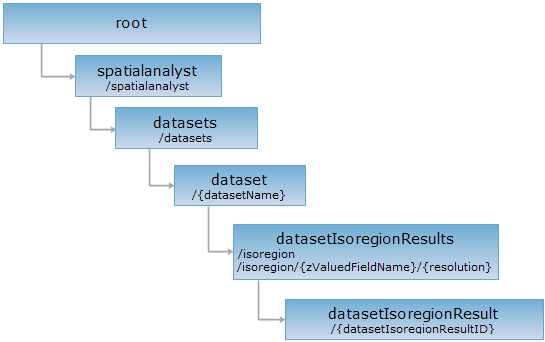URI
<datasetIsoregionResults_uri>/{datasetIsoregionResultID}.[<format>]
Supported methods
Parent resource
Introduction
The datasetIsoregionResult resource represents an isoregion extraction result.
Supported methods:
- GET: Gets the resource of an isoregion extraction result.
- HEAD: Checks if the datasetIsoregionResult resource exists, or if there is permission to access the datasetIsoregionResult resource.
Supported output formats: rjson, json, html, xml.
GIS Services Resource Hierarchy

HTTP request methods
Below is an example of performing an HTTP request on a URI with rjson as the output format. supermapiserver in the URI is the name of the server.
http://supermapiserver:8090/iserver/services/spatialanalyst-sample/restjsr/spatialanalyst/datasets/SamplesP@Interpolation/isoregion/1.rjson
GET request
Returns the description information about the resource of an isoregion extraction result.
Response structure
Normal response code(s): 200.
The response structure is as follows after a GET request is performed on the resource:
| Field | Type | Description |
| succeed | boolean | Whether the spatial analysis was successful. |
|
message |
String | The returned message when the spatial analysis failed. |
| dataset | String | The ID of the result dataset. |
| recordset | Recordset | The result record set for storing information about the spatial objects. When performing a post request on the datasetIsoregionResults resource, the information on the objects in the result dataset is displayed only if the dataReturnMode attribute of the dataReturnOption field is set to return Recordset. |
Example usage
The following result in RJSON format is returned after a GET request is performed on the resource:
{
"dataset": "PointIsoregion@Interpolation",
"message": null,
"recordset": null,
"succeed": true
}
HEAD request
Returns the same HTTP response header as GET does, but no response entity is included. HEAD request can be used to get metadata from the response message header without transporting the entire response content. Metadata includes information about the media type, character encoding, compression encoding, the length of the entity content, etc.
HEAD request can be used to check if the datasetIsoregionResult resource exists, or if the resource can be accessed by clients. It can also determine if the datasetIsoregionResult resource supports an output format <format> if performed on a URI with .<format> included.